 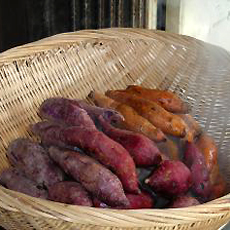
Sweet potatoes come in a riot of colors. Photo by Pearlie Ng | SCX.
February 2008
|
 |
The Difference Between Sweet Potatoes & Yams
The Difference Between A Sweet Potato And A Yam Is No Joke
Some people think they’re the same thing. Even producers stencil both names on the same box, since the U.S. Department of Agriculture requires that the label “yam” always be accompanied with the words “sweet potato” when referring to a sweet potato. No wonder the poor consumer is confused. Hasn’t anyone told the USDA that these are separate vegetables that are not in the least related? Why should “yam” be on a sweet potato box in the first place.
Which leads us to that old joke: What’s the difference between a sweet potato and a yam? About ten cents a pound. [Adjust joke for inflation.]
Sweet Potatoes
Sweet potatoes, indigenous to Central America, are a totally different plant family from yams, as you’ll see in the chart below. In fact, they are a member of the genus that 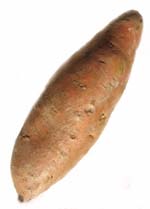 contains morning glories, and when the plant is in flower, the flowers look like morning glories. They are only distantly related to the potato, which is indigenous to Peru. There are seven varieties of sweet potato. The moist, sweet flesh can be white, yellow, orange or purple. The smooth, thin skin can be orange-brown, red, purple or white. Sweet potatoes are blocky, with tapered ends. contains morning glories, and when the plant is in flower, the flowers look like morning glories. They are only distantly related to the potato, which is indigenous to Peru. There are seven varieties of sweet potato. The moist, sweet flesh can be white, yellow, orange or purple. The smooth, thin skin can be orange-brown, red, purple or white. Sweet potatoes are blocky, with tapered ends.
Orange-fleshed sweet potatoes made their way north from Peru and Ecuador and have been grown by native Americans, and subsequently cultivated in the southern U.S., since Colonial times. There are two different varieties of this sweet potato, which will explain why some sweet potatoes aren’t so sweet, or so colorful. The paler-skinned sweet potato is softer with a thin, light yellow skin and pale yellow flesh; it has a dry, crumbly texture similar to a white baking potato. The harder, darker-skinned sweet potato is that which we generally think of when we think of that sweet, orange flesh with the sweeter flavor. These two varieties, commonly available in supermarkets, further confuse consumers. Might the more orange-fleshed one be a sweet potato and the pale-fleshed one a yam? Nope.
Yams
Authentic yams are white-fleshed, starchy tubers that come from Africa. They have rough, scaly skin and are long and cylindrical—some with a split bottom creating "toes.” Their flesh is dry and starchy. They grow long—at the extreme, up to seven feet in length—and are cut and sold in sections.
Here’s how the colorful sweet potato, indigenous to South America, took on the name 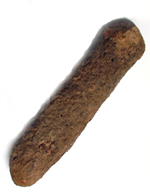 of the nyami (Anglicized to yam), the totally unrelated starchy tuber from Africa. of the nyami (Anglicized to yam), the totally unrelated starchy tuber from Africa.
The confusion began in the Antebellum era. The African slaves called the softer sweet potatoes cultivated in America “yams” because they resembled the nyami they knew from home. There were no nyami in America at the time: African and Caribbean immigrants wouldn’t cause import of real nyami, the white-fleshed African yam, to America until the latter 20th century, when they would appear in international grocery stores. By that time, most of America had only known “yams” as yellow-fleshed potatoes that weren’t particularly sweet. Some myths went so far as to say that yams were older sweet potatoes, after the sugar had converted to starch and the more colorful flesh had faded.
The Confusion Continues
Those encountering the long, rough, brown tubers called yams in international markets–or ordering yams in Caribbean restaurants and getting something white and starchy—have every right to be thoroughly confused. We are living in a multi-yam society. Perhaps it‘s time to go back to the terms sweet potato (domestic) and yam (African); or at least, domestic yam (sweet potato) and African yam (true yam).
The Final Word
Here’s a comparison to master; then you can help rid the world of yam ignorance.
| |
Sweet Potato & Domestic Yam |
True Yam |
| |
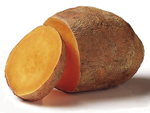 |
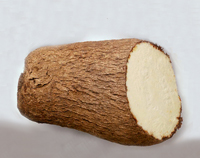 |
| Scientific Name |
Ipomoea batatas |
Dioscorea Species |
| Plant Family |
Morning Glory (Convolvulaceae) |
Yam (Dioscoreaceae) |
| Origin |
South America (Peru, Ecuador) |
West Africa, Asia |
| Age |
Prehistoric |
50,000 B.C.E. |
| Skin |
Smooth and thin; yellow/tan to darker orange/tan, red and purple |
Rough and scaly; the color is brown or brownish-black |
| Flesh |
The color can range from white to yellow, orange, or orange-red |
Generally white, although some varieties can have purple or red flesh |
| Shape |
Short, blocky, tapered ends |
Long, cylindrical, some with “toes”; often sold in chunks, since they can grow to 7 feet in length |
| Mouthfeel |
Moist* |
Dry |
| Taste |
Sweet* |
Starchy |
| Calories, ½ Cup |
103 |
79 |
| Provenance |
United States |
Caribbean |
| Varieties |
Sweet potatoes: Jersey, Kotobuki (Japanese), Okinawan (Purple), Papa Doc
Yams: Beauregard, Covington, Garnet, Jewel
|
There are about 500 species of the genus Dioscorea of the Dioscoreaceae family |
*Most varieties grown in the U.S.
© Copyright 2005-
Lifestyle Direct, Inc. All rights reserved. Images are the copyright of their respective owners.

|



 contains morning glories, and when the plant is in flower, the flowers look like morning glories. They are only distantly related to the potato, which is indigenous to Peru. There are seven varieties of sweet potato. The moist, sweet flesh can be white, yellow, orange or purple. The smooth, thin skin can be orange-brown, red, purple or white. Sweet potatoes are blocky, with tapered ends.
contains morning glories, and when the plant is in flower, the flowers look like morning glories. They are only distantly related to the potato, which is indigenous to Peru. There are seven varieties of sweet potato. The moist, sweet flesh can be white, yellow, orange or purple. The smooth, thin skin can be orange-brown, red, purple or white. Sweet potatoes are blocky, with tapered ends.  of the nyami (Anglicized to yam), the totally unrelated starchy tuber from Africa.
of the nyami (Anglicized to yam), the totally unrelated starchy tuber from Africa. 
